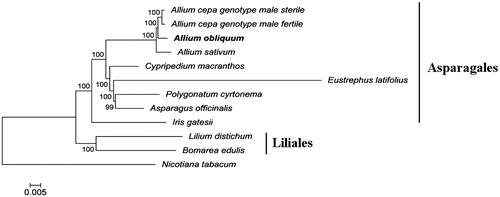Abstract
The complete chloroplast genome sequence of Allium obliquum was determined by Illumina single-end sequencing. The complete plastid genome was 152,387 bp in length, containing a large single copy (LSC) of 81,588 bp and a small single copy (SSC) of 18,059 bp, which were separated by a pair of 26,370 bp inverted repeats (IRs). A total of 134 genes were annotated, including 83 protein coding genes, 38 tRNA genes, eight rRNA genes, and five pseudogenes. The overall GC contents of the plastid genome were 36.8%. Unlike A. cepa (onion) and A. sativum (garlic), A. obliquum encodes a functional intact infA gene.
Lop-sided onion, Allium obliquum L., is a perennial bulbous plant with wide geographic distribution in Eurasia from Romania to China and Mongolia. It is popular as an ornamental plant because of the spectacular yellow inflorescences (Seregin et al. Citation2015). Young leaves A. obliquum are used by local people as food in places of growth (Friesen Citation1988).
The plastid DNA A. obliquum (cultivar Novichok; seed from Federal Scientific Vegetable Center, Moscow oblast, Russia) was amplified via long range PCR using 11 pairs of primers developed on the basis of the Allium cepa plastid genome (KF728079, NC_024813), sequencing was conducted using the Illumina HiSeq 1500 Sequencing System with single-end 220 bp reads. Spades v.3.8 was used to assemble the high-quality short reads into contigs (Bankevich et al. Citation2012). Contigs were assembled against the complete A. cepa plastome as a reference (NC_024813). Gaps were closed using assembly graph in Bandage (Wick et al. Citation2015), reads were then mapped against the resulting single contig to ensure the correctness of the finished assembly. The plastid genome of A. obliquum was annotated by using the DOGMA program (http://dogma.ccbb.utexas.edu). The start and stop codons for the genes were identified and corrected manually. A circular plastid genome map of A. obliquum was drawn using the OGDRAW program (Lohse et al. Citation2013).
The assembled A. obliquum plastid genome (MG670111) was 152,387 bp in length, showing a typical quadripartite structure including a pair of inverted repeats (IRs) of 26,370 bp separating one large single copy (LSC) region of 81,588 bp and one small single copy (SSC) region of 18,059 bp. GC contents of the genome were 36.8%. A total of 134 genes were identified that include 83 protein-coding genes, 38 tRNA genes, eight rRNA genes, and five pseudogenes.
Most of the genes are single copy, whereas 18 genes present in double copies, including six protein-coding genes (rps19, rpl2, rpl23, ycf2, ndhB, and rps7), eight tRNA genes (trnR-ACG, trnL-CAA, trnV-GAC, trnH-GUG, trnI-CAU, trnI-GAU, trnA-UGC, and trnN-GUU), and all four rRNA genes in IRs (rrn4.5, rrn5, rrn16, and rrn23). All genes had a common start codon (ATG) in the initiation site, except rps19, which carried GTG as a start codon. Intron sequences are found in 17 genes, 15 of which contain a single intron (atpF, rpoC1, ndhA, trnK-UUU, trnG-GCC, trnL-UAA, and trnV-UAC; four genes in IRs: rpl2, ndhB, trnI-GAU, and trnA-UGC), while two (clpP and ycf3) have two introns.
Five genes became pseudogenes due to internal stop codons (rps2, two ycf15 in IRs) or because of incomplete duplication in the IRB/SSC junction region (ycf1) and the exon II deletion of the rps16 gene (verified by additional sequencing). Allium obliquum encodes a functional intact infA gene unlike A. cepa (NC_024813; von Kohn et al. Citation2013) and A. sativum (NC_031829; Filyushin et al. Citation2016) where infA was found to be a pseudogene.
The ML tree was clearly divided into two clades with the order level, Asparagales and Liliales. Allium obliquum is clustered with other sampled Allium species with 100% bootstrap values ().
Figure 1. Phylogenetic tree inferred by maximum-likelihood using 82 protein-coding gene sequences of 10 species including seven species from the Asparagales order: Allium cepa (genotype male sterile KF728079 and genotype male fertile NC_024813), Allium sativum (NC_031829), Eustrephus latifolius (KM233639), Polygonatum cyrtonema (KT630835), Cypripedium macranthos (KF925434), Asparagus officinalis (NC_034777), Iris gatesii (KM014691); two species from Liliales order: Bomarea edulis (NC_025306), Lilium distichum (NC_029937); and Nicotiana tabacum (NC_001879) as an outgroup. PhyML 3.1 (Guindon et al. Citation2010) was used for the sequence alignment and construction of the tree. Bootstrap support values based on 1000 replicates are displayed on each node.

Disclosure statement
The authors report no conflicts of interest. The authors alone are responsible for the content and writing of this article.
Additional information
Funding
References
- Bankevich A, Nurk S, Antipov D, Gurevich AA, Dvorkin M, Kulikov AS, Lesin VM, Nikolenko SI, Pham S, Prjibelski AD, et al. 2012. SPAdes: a new genome assembly algorithm and its applications to single-cell sequencing. J Comput Biol. 19:455–477.
- Filyushin МА, Beletsky AV, Mazur AM, Kochieva EZ. 2016. The complete plastid genome sequence of garlic Allium sativum L. Mitochondrial DNA B. 1:831–832.
- Friesen NV. 1988. Lukovye Sibiri: sistematika, kariologiya, khorologiya (Russian). Novosibirsk, USSR.
- Guindon S, Dufayard JF, Lefort V, Anisimova M, Hordijk W, Gascuel O. 2010. New algorithms and methods to estimate maximum-likelihood phylogenies: assessing the performance of PhyML 3.0. Syst Biol. 59:307–321.
- Lohse M, Drechsel O, Kahlau S, Bock R. 2013. OrganellarGenomeDRAW—a suite of tools for generating physical maps of plastid and mitochondrial genomes and visualizing expression data sets. Nucl Acids Res. 41:575–581.
- Seregin AP, Anačkov G, Friesen N. 2015. Molecular and morphological revision of the Allium saxatile group (Amaryllidaceae): geographical isolation as the driving force of underestimated speciation. Bot J Linn Soc. 178:67–101.
- von Kohn CM, Kielkowska A, Havey MJ. 2013. Sequencing and annotation of the chloroplast DNAs of normal (N) male-fertile and male-sterile (S) cytoplasms of onion and single nucleotide polymorphisms distinguishing these cytoplasms. Genome. 56:737–742.
- Wick RR, Schultz MB, Zobel J, Holt KE. 2015. Bandage: interactive visualization of de novo genome assemblies. Bioinformatics. 31:3350–3352.
